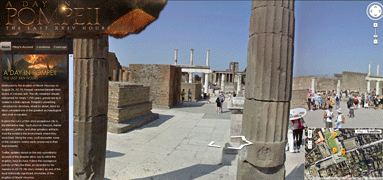-
by Amy Corr
, Staff Writer,
September 17, 2012
Thanks to social media and smartphones, breaking news is recorded, posted and shared with a rapidity unheard of in days past. How would past historic events have been covered had social media
existed?
That’s the idea behind an online and social media campaign for Denver Museum of Nature & Science’s exhibition, A Day in Pompeii. The campaign launched
on Aug. 24, the anniversary of the eruption of Mount Vesuvius in 79 A.D. Created by Carmichael Lynch, the campaign consists of a website that allows users to
experience the last 24 hours in Pompeii through the eyes of Pliny the Elder, in the lone existing eyewitness account.
Using Google Maps, users can stroll through Pompeii, unearthing sculptures
and pottery as one explores the ruins street by street.
In addition to the site launch on Aug. 24,a Twitter feed belonging to Pliny the Elder
debuted, reflecting hourly updates on the eruption of Mount Vesuvius.
 Within 24 hours, Pliny had more than 4,000 Twitter followers. Although he stopped tweeting, for obvious reasons, his Twitter followers increased to nearly 4,500.
Within 24 hours, Pliny had more than 4,000 Twitter followers. Although he stopped tweeting, for obvious reasons, his Twitter followers increased to nearly 4,500.
This modern twist on reporting a tragic event included tweets from Pliny like: “Woke up to violent shaking. The courtyard is full of ash and pumice” and “It’s daytime, but
blacker than any night.”
The exhibition runs from Sept.14 to Jan. 13.
“The Museum's social media channels helped spread the word to their fans about Pliny the Elder's
Twitter account and the campaign website,” said Dave Damman, Chief Creative Officer at Carmichael Lynch. “In addition, Pliny the Elder began to follow historians, volcanists and geologists
on Twitter prior to his 24-hour tweeting, to build excitement in the Twittersphere.”